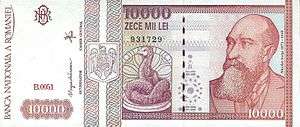Glycon
| Glycon | |
|---|---|
|
| |
| Major cult center | Abonoteichos |
Glycon (Ancient Greek: Γλύκων Glýkon, gen: Γλύκωνος Glýkonos), also spelled Glykon, was an ancient snake god. Having a large and influential cult within the Roman Empire in the 2nd century; Glycon had been mentioned earlier by Horace. However contemporary satirist Lucian provides the primary literary reference to the deity. Lucian claimed Glycon was created in the mid-2nd century by the Greek prophet Alexander of Abonoteichos. Lucian was ill-disposed toward the cult, calling Alexander a false prophet and accusing the whole enterprise of being a hoax: Glycon himself was supposedly a hand puppet.[1]
Macedonian cultural roots
The cult possibly originated in Macedonia, where similar snake cults had existed for centuries. The Macedonians believed snakes had magical powers relating to fertility and had a rich mythology on this subject, for example the story of Olympias's impregnation by Zeus disguised as a serpent. In 20 BC Glycon was referred to by the Roman poet Horace, in his Epistle 1 to Maecenas in his First Book of Epistles; "... you despair of the muscles of the invincible Glycon...").
Early years
At least initially, the cult did not worship an abstraction or a spirit of a snake but an actual, physical serpent that was said to embody the god. According to the cult's mythology, the snake appeared after Alexander had foretold the coming of a new incarnation of Asclepius. When the people gathered in the marketplace of Abonutichus at noon, when the incarnation was supposed to occur, Alexander produced a goose egg and sliced it open, revealing the god within. Within a week it grew to the size of a man with the features of a man on its face, including long blond hair. At this point the figure resembling this description was apparently a puppet that appeared in the temple. In some references Glycon was a trained snake with a puppet head.
As with previous Macedonian snake cults, the focus of worship at the temple was on fertility. Barren women would bring offerings to Glycon in hopes of becoming pregnant. According to Lucian, Alexander had less magical ways of causing pregnancy among his flock as well.
Spread and influence
By 160, the worship of Glycon had undoubtedly spread beyond the Aegean. An inscription from Antioch of that date records a slogan, "Glycon protect us from the plague-cloud" that is consistent with the description we have from Lucian. Also in that year the governor of Asia, Publius Mummius Sisenna Rutilianus, declared himself protector of Glycon's oracle. The governor later married Alexander's daughter. According to Lucian, another Roman governor, of Cappadocia, was led by Glycon's oracle to his death in Armenia, and even the Emperor himself was not immune to the cult: Marcus Aurelius sought prophesies from Alexander and his snake god.
Meanwhile, Abonoteichos, a small fishing village before the arrival of the cult, became an important town and accepted another name, Ionopolis. It is uncertain what role the popularity of Glycon played in the rise of the city.
In short order Glycon worship was found throughout the vast area between the Danube and Euphrates. Beginning late in the reign of Antoninus Pius and continuing into the 3rd century, official Roman coins were struck in honor of Glycon, attesting his popularity. While the cult gradually lost followers after the death of its leader in c.170, it survived for at least a hundred years thereafter, with Alexander being incorporated into its mythology as a grandson of Asclepius. Some evidence indicates the cult survived into the 4th century.
Modern times

Residual superstitions originating with Glycon were reported by some researchers to continue even into modern times. A Turkish friend of Dutch scholar Jona Lendering mentioned that a common belief in a magical snake persisted near İnebolu (the current name for the ancient city of Ionopolis).[2]
Following his "coming out" as a magician in 1993, the English comic book writer and occultist Alan Moore has declared himself a devotee of Glycon. At the same time, he acknowledges that Glycon was almost certainly a hoax.[3]
One single marble statue of Glycon snake was found in excavations done under the site of the former Pallas railway station in Constanța, Romania. The statue is 0.66 metres high and the snake dimension is 4.76 metres.[4] The Romanians commemorated this unique sculpture on a postage stamp in 1974, and on a bank note of 10.000 lei in 1994.
See also
Notes
- ↑ {Λουκιανοῦ Ἀλέξανδρος ἢ Ψευδομάντις}, Lucian's "Alexander or the False Prophet", 18–20
- ↑ "A Turkish friend of the author of the present article once told him that in the early 1970's, when he was hunting in the hills near Inebolu, people warned him for a magical snake." Lendering, Jona. "Glykon". www.livius.org. LIVIVS.
- ↑ Wolk, Douglas (17 December 2003). "Sidebar: How Alan Moore transformed American comics". Slate. Archived from the original on 10 September 2008. Retrieved 10 September 2008.
- ↑ Vatamanu Nicolae: "Esculap reincarnat in Glycon, sarpele cu plete", Viața Medicală 1972, No.7 pg 333–335
References
- A.M. Harmon, Introduction to Lucian of Samosata
- Greek text of Lucian: Alexander or the False Prophet, with modern Greek translation by A.M. Harmon, 1925
- Works by Lucian of Samosata at Project Gutenberg
- C.P. Jones, Culture and Society in Lucian (1986)
- M.S. Kos, "Draco and the survival of the snake cult in the central Balkans", in: Tyche 6 (1991)
- R. Lane Fox, Pagans and Christians in the Mediterranean World (1986)
- Wolk, Douglas, Please, Sir, I Want Some Moore: The lazy British genius who transformed American comics(2003)
- Wilson, Rainn, The Bassoon King: my life in art, faith, and idiocy (2015)
External links
- Alan Moore's alternative Thought for the Day – on BBC Radio 4's Today programme
- The Worship of the Serpent – Chapter 1: Serpent Worship in Asia by John Bathurst Deane 1833
